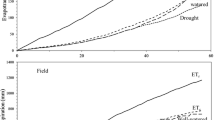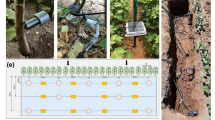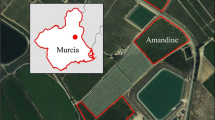Abstract
In this study, the thickness of cowpea leaves was measured with high data- and time-resolution, and the dynamics of leaf thickness was subsequently used as an input parameter for automated irrigation control at the greenhouse level. Under non-stressful environmental conditions, leaf thickness showed only minor diurnal and almost no nocturnal fluctuations. In an extreme water deficit stress scenario, leaf thickness decreased dramatically by as much as 45% within a short period of time. In a more realistic situation, leaf thickness was kept fairly constant for several days, but decreased substantially when water deficit stress became too severe for the plants to cope with any longer. This characteristic collapse of leaf thickness was used as an input parameter for the automated initiation of irrigation. Upon automated irrigation, plants re-established their nominal leaf thickness quickly and kept this leaf thickness constant for several days, until signaling the need for the next irrigation by a subsequent decrease of leaf thickness. By using the measurement of leaf thickness for irrigation control, between 25 and 45% of irrigation water could be conserved compared with a typical timed irrigation schedule.









Similar content being viewed by others
References
Alarcon JJ, Malone M (1994) Substantial hydraulic signals are triggered by leaf-biting insects in tomato. J Exp Bot 45:953–957
Bachmann F (1922) Studien über die Dickenänderung von Laubblättern. Jahrb wiss Bot 61:372–429
Búrquez A (1987) Leaf thickness and water deficit in plants: a tool for field studies. J Exp Bot 38:109–114
Carpenter SB, Smith ND (1979) Variations in shade leaf thickness among urban trees growing in metropolitan Lexington, Kentucky. Castanea 44:94–98
Carpenter SB, Smith ND (1981) A comparative study of leaf thickness among southern Appalachian hardwoods. Can J Bot 59:1393–1396
Chaney WR (1970) A device for the continuous monitoring of changes in leaf thickness. Forest Sci 16:56
Cooper RL, Ware JV, Cass DD (2004) Leaf thickness of Salix spp. (Salicaceae) from the Athabasca sand dunes of northern Saskatchewan, Canada. Can J Bot 82:1682–1686
Danson FM, Steven MD, Malthus TJ, Clark JA (1992) High spectral resolution data for determining leaf water content. Int J Remote Sens 13:461–470
Esau K (1977) Anatomy of seed plants. Wiley, New York
Friend DJ (1961) Control of chlorophyll accumulation in leaves of Marquis wheat by temperature and light intensity. II. Chlorophyll contents relative to leaf area and thickness. Physiol Plant 14:28–39
Gausman HW (1974) Leaf reflectance of near-infrared. Photogramm Eng 40:183–191
Gausman HW, Allen WA, Cardenas R, Richardson AJ (1970) Relation of light reflectance to historical and physical evaluations of cotton leaf maturity. Appl Opt 9:545–552
Hanba YT, Miyazawa SI, Terashima I (1999) The influence of leaf thickness on the CO2 transfer conductance and leaf stable carbon isotope ratio for some evergreen tree species in Japanese warm-temperature forests. Funct Ecol 13:632–639
Heilman MD, Gonzales CL, Swanson WA, Rippert WJ (1968) Adaptation of a linear transducer for measuring leaf thickness. Agron J 60:578
Kadoya K (1978) Studies on hydrophysiological rhythms of citrus trees. III. Effect of soil-temperature on cyclic fluctuations of leaf thickness. J Jpn Soc Hortic Sci 47:167–171
Li J, Yang J, Fei P, Song J, Li D, Ge C, Chen W (2009) Responses of rice leaf thickness, SPAD readings and chlorophyll a/b ratios to different nitrogen supply rates in paddy field. Field Crops Res 114:426–432
Malone M (1992) Kinetics of wound-induced hydraulic signals and variation potentials in wheat seedlings. Planta 187:505–510
Malone M, Alarcon JJ (1994) Only xylem-borne factors can account for systemic wound signaling in the tomato plant. Planta 196:740–746
Marenco RA, Antezana-Vera SA, Nascimento HCS (2009) Relationship between specific leaf area, leaf thickness, leaf water content and SPAD-502 readings in six Amazonian tree species. Photosynthetica 47:184–190
McBurney T (1992) The relationship between leaf thickness and plant water potential. J Exp Bot 43:327–335
McCain DC, Croxdale J, Markley JL (1988) Water is allocated differently in chloroplasts in sun and shade leaves. Plant Physiol 86:16–18
Meidner H (1952) An instrument for the continuous determination of leaf thickness changes in the field. J Exp Bot 3:319–325
Niinemets U (1999) Components of leaf dry mass per area–thickness and density–alter leaf photosynthetic capacity in reverse directions in woody plants. New Phytol 144:35–47
Nobel PS, Hartsock TL (1981) Development of leaf thickness for Plectranthus parviflorus–influence of photosynthetically active radiation. Physiol Plant 51:163–166
Rozema J, Arp W, Van Diggelen J, Kok E, Letschert J (1987) An ecophysiological comparison of measurements of the diurnal rhythm of the leaf elongation and changes of the leaf thickness of salt-resistant dicotyledonae and monocotyledonae. J Exp Bot 38:442–453
Semerdjieva SI, Phoenix GK, Hares D, Gwynn-Jones D, Callaghan TV, Sheffield E (2003) Surface morphology, leaf and cuticle thickness of four dwarf shrubs from a sub-Artic heath following long-term exposure to enhanced levels of UV-B. Physiol Plant 117:289–294
Sharon Y, Bravdo B-A (1996) Irrigation control for citrus according to the diurnal cycling of leaf thickness. Proceedings of the international conference on water & irrigation, Tel Aviv, Israel, pp 273–283
Sinclair TR (1968) Pathway of solar radiation through leaves. M.S. thesis, Purdue University, Lafayette, IN
Sinclair TR, Ludlow MM (1985) Who taught plants thermodynamics? The unfulfilled potential of plant water potential. Aust J Plant Physiol 12:213–217
Syvertsen J, Levy Y (1982) Diurnal changes in citrus leaf thickness, leaf water potential, and leaf to air temperature difference. J Exp Bot 33:783–789
Taiz L, Zeiger E (eds) (2006) Plant physiology, 4th edn. Sinauer Associates, Sunderland
Terashima I, Hanba YT, Tazoe Y, Vyas P, Yano S (2006) Irradiance and phenotype: comparative eco-development of sun and shade leaves in relation to photosynthetic CO2 diffusion. J Exp Bot 57:343–354
Thomas JR, Namken LN, Oerther GG, Brown RG (1971) Estimating leaf water content by reflectance measurements. Agron J 63:845–847
Tyree MT, Cameron SI (1977) A new technique for measuring oscillatory and diurnal changes in leaf thickness. Can J For Res 7:540–544
Vile D, Garnier É, Shipley B, Laurent G, Navas M-L, Roumet C, Lavorel S, Diaz S, Hodgson JG, LLoret F, Midgley GF, Poorter H, Rutherford MC, Wilson PJ, Wright IJ (2005) Specific leaf area and dry matter content estimate thickness in laminar leaves. Ann Bot 96:1129–1136
Vogelmann TC, Bornman JF, Josserand S (1989) Photosynthetic light gradients and spectral regime within leaves of Medicago sativa. Philos Trans R Soc Lond Ser B 323:411–421
White JW, Montes-R C (2005) Variation in parameters related to leaf thickness in common bean (Phaseolus vulgaris L.). Field Crops Res 91:7–21
Yun JI, Taylor SE (1986) Adaptive implications of leaf thickness for sun- and shade-grown Abutilon theophrasti. Ecology 67:1314–1318
Acknowledgments
This study was supported by the National Science Foundation, award-number 0712605. We also would like to thank Tom Lemieux of the University of Colorado’s greenhouse for his advice, Dr. Ken Knutson of the College of Agricultural Sciences at Colorado State University for his review comments, and the anonymous journal-reviewers for their comments.
Author information
Authors and Affiliations
Corresponding author
Additional information
Communicated by E. Fereres.
Rights and permissions
About this article
Cite this article
Seelig, HD., Stoner, R.J. & Linden, J.C. Irrigation control of cowpea plants using the measurement of leaf thickness under greenhouse conditions. Irrig Sci 30, 247–257 (2012). https://doi.org/10.1007/s00271-011-0268-2
Received:
Accepted:
Published:
Issue Date:
DOI: https://doi.org/10.1007/s00271-011-0268-2




